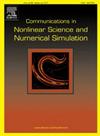A structure-preserving parametric finite element method for solid-state dewetting on curved substrates
IF 3.4
2区 数学
Q1 MATHEMATICS, APPLIED
Communications in Nonlinear Science and Numerical Simulation
Pub Date : 2025-03-19
DOI:10.1016/j.cnsns.2025.108767
引用次数: 0
Abstract
We consider a two-dimensional sharp-interface model for solid-state dewetting of thin films with anisotropic surface energies on curved substrates, where the film/vapor interface and the substrate surface are represented by an evolving curve and a static curve, respectively. The continuum model is governed by the anisotropic surface diffusion for the evolving curve, with appropriate boundary conditions at the contact points where the two curves meet. The model obeys an energy decay law and preserves the enclosed area between the two curves. We introduce an arclength parameterization for the substrate curve, which plays a crucial role in a structure-preserving approximation as it straightens the curved substrate and tracks the length changes between the contact points. Based on this insight, we introduce a symmetrized weak formulation which leads to an unconditional energy stable parametric approximation in terms of the discrete energy. We also provide an error estimate of the enclosed area, which depends on the substrate profile and can be zero in the case of a flat substrate. Furthermore, we introduce a correction to the discrete normals to enable an exact area preservation for general curved substrates. The resulting nonlinear system is efficiently solved using a hybrid iterative algorithm which combines both Picard and Newton’s methods. Numerical results are presented to show the robustness and good properties of the introduced method for simulating solid-state dewetting on various curved substrates.
求助全文
约1分钟内获得全文
求助全文
来源期刊

Communications in Nonlinear Science and Numerical Simulation
MATHEMATICS, APPLIED-MATHEMATICS, INTERDISCIPLINARY APPLICATIONS
CiteScore
6.80
自引率
7.70%
发文量
378
审稿时长
78 days
期刊介绍:
The journal publishes original research findings on experimental observation, mathematical modeling, theoretical analysis and numerical simulation, for more accurate description, better prediction or novel application, of nonlinear phenomena in science and engineering. It offers a venue for researchers to make rapid exchange of ideas and techniques in nonlinear science and complexity.
The submission of manuscripts with cross-disciplinary approaches in nonlinear science and complexity is particularly encouraged.
Topics of interest:
Nonlinear differential or delay equations, Lie group analysis and asymptotic methods, Discontinuous systems, Fractals, Fractional calculus and dynamics, Nonlinear effects in quantum mechanics, Nonlinear stochastic processes, Experimental nonlinear science, Time-series and signal analysis, Computational methods and simulations in nonlinear science and engineering, Control of dynamical systems, Synchronization, Lyapunov analysis, High-dimensional chaos and turbulence, Chaos in Hamiltonian systems, Integrable systems and solitons, Collective behavior in many-body systems, Biological physics and networks, Nonlinear mechanical systems, Complex systems and complexity.
No length limitation for contributions is set, but only concisely written manuscripts are published. Brief papers are published on the basis of Rapid Communications. Discussions of previously published papers are welcome.
 求助内容:
求助内容: 应助结果提醒方式:
应助结果提醒方式:


